
UNIVERSIDADE FEDERAL DE MINAS GERAIS
FACULDADE DE LETRAS
CURSO DE ESPECIALIZAÇÃO EM INGLÊS
AUTORA: CELIA MARIA MASSOTE DAWSON
FOOD AND DRINK - A GENRE-BASED TEACHING UNIT
BELO HORIZONTE, 2009.
Warm up
What is essential in life?
Can you cook?
Do you think learning how to cook is important?
Vocabulary

Images from www.jamieoliver.com
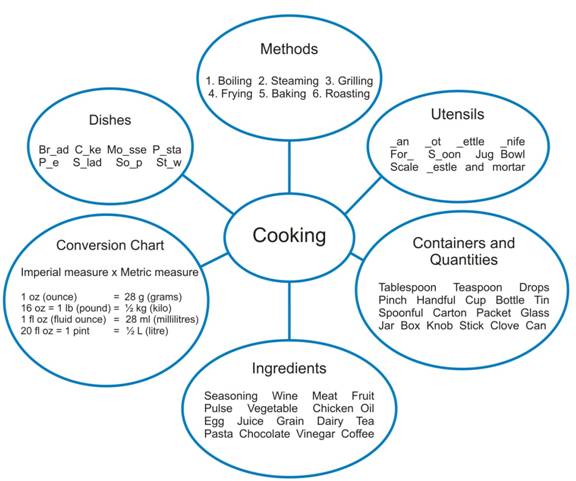
1 - a) In pairs, match the six pictures to the cooking methods in the vocabulary anagram.
b) Give two more examples of food usually cooked in each way.
2 - a) Complete the dish words of the anagram with a vowel letter.
b) Complete the utensil words with a P or a K.
3 – a) What are the dry measures and the liquid measures in the conversion chart?
b) Think of a collocation for each word from Containers & Quantities.
E.g.: A packet of biscuits, a clove of garlic, a few drops of pepper sauce, etc.
4 – In pairs, complete the boxes with a heading for each group of cooking ingredients. Look at the vocabulary anagram and use a dictionary to help you. Mark the stress and practice saying all the words.
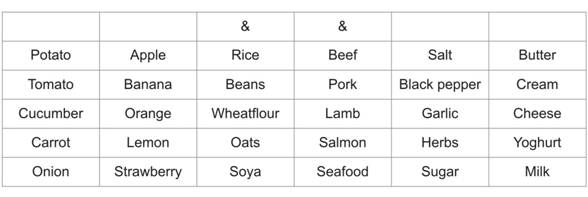
5 – Can you think of any other food or drink used for cooking? Ask other pairs for additions to your lists.
Pronunciation
1 – How do you pronounce the sound symbols and words?
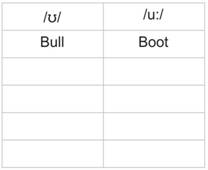
Food Cook Fruit Soup Sugar Stew Book Handful
Listening
1 - Do you ever watch cooking shows on television?
a) What are the aims of these TV programmes?
b) Who is your favourite `Celebrity chef`?
2 – Cover the song text. Listen and answer. – CD Listening 2
a) What is the song about?
b) There are two people singing. Do you recognise the male`s voice?
FISH STEW Verse 1 This fishy love, fishy love is what I've waited for, And now you've shown me how, I just want a Fish Stew more, This fishy love, fishy love is something I can do, And now you've shown me how, I want a FISH STEW. {Human Beat box} SHAKIN IT UP There's something fishy going on SHAKIN IT UP That's why I wrote this song SHAKIN IT UP (Scooby doo) WHAT DO WE WANT? Repeat Chorus |
Words & music by Leigh Haggerwood
Vocals performed by Jamie Oliver & Nina Clarke
Source: Lyrics from http://www.jamies-music.com/ and music downloaded from iTunes
3 – Listen to the song again and complete the lyrics with the ingredients from the vocabulary section. Compare answers with your partner.
4 – Listen again for singing along.
Grammar
1 - Look at the highlighted verbs in the lyrics of 'Fish stew'. Discuss in groups:
a) Are they in any particular verb tense?
b) What person of the verb do they refer to? Why?
c) How can we make a negative command?
d) Check with the Grammar Reference – "Instructions" - page 13.
2 - The imperative mood can be applied to all the example situations, except:
a) Giving directions for street destination. c) Asking for water at a friend`s house.
b) A manual for an electronic device. d) The commands for tasks in this book.
3 – What do you call a set of instructions on how to prepare and cook food?
a) A receipt c) A prescription
b) A recipe d) A list
4 – Here are some other verbs used to give directions on how food is prepared and cooked.
a) Mark them with a C (cutting), M (mixing) and H (heating).
| ( ) Stir | ( ) Slice |
( ) Pour | ( ) Grate | ( ) Beat |
| ( ) Knead | ( ) Mince | ( ) Pound | ( ) Melt | ( ) Peel |
| ( ) Dice | ( ) Carve | ( ) Chop | ( ) Simmer | ( ) Shred |
b) Match the columns to form cooking commands. Practice saying the phrases.
| Melt | the egg whites |
| Chop | the potatoes |
| Pour | the butter |
| Grate | the meat |
| Beat | the tomato |
| Peel | the milk |
| Carve | the onions |
| Slice | the parmesan cheese |
Reading
1 – Have you got any cookbooks at home? Have you ever tried to prepare any of the dishes? Would you like to try to make a recipe?
2 – Celebrity chef Jamie Oliver is also a great cookery book writer. Read one of his recipes and say if it looks simple or complicated to prepare? Why?
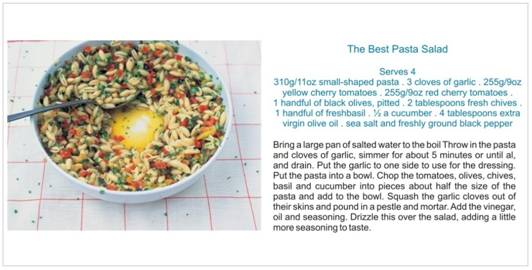
Source: "Happy Days with the Naked Chef" by Jamie Oliver
3 – Read the recipe again and guess the meaning of these verbs:
a) Throw in
b) Squash
c) Drizzle
4 – How many ingredients are used for the dressing? Which ones are they?
5 – Take your books to the school kitchen and try this dish. Take turns to read the instructions aloud and help with the preparation. Enjoy your meal!
Speaking
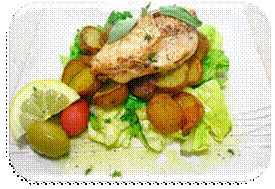
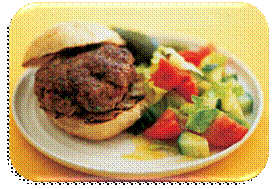
Images from www.jamieoliver.com
1 – In pairs, look at the pictures and talk about the food in each dish.
2 – a) Now, you and your partner will have to decide for one of the dishes, so persuade your partner to accept your choice. Give it a name and together, write its recipe in two parts: a list of ingredients with quantities, and the step-by-step directions on how to make it.
b) Exchange recipes with another pair and check each other`s writing for spelling and collocation mistakes. Is there anything you can do to improve your work or your colleagues`?
Homework
Invite your partner to your place, share the costs for buying the ingredients and try to make your own dishes. Write down any adjustment you wish to make to your recipe. Don`t forget to speak as much English as possible while doing this task. Take pictures of the preparation and the completed dish and report your experience to your classmates. Was it 10 out of 10?
Writing
Jamie Oliver has won many prizes for his Healthy Eating projects. In his latest one, he wishes to stimulate young people to start cooking. He intends to compile a book with recipes from all over the world, so he is asking students of English to write a recipe for the dish from their country they would most miss if they went to live abroad. Write your recipe and after trying it and correcting its text, send it with a picture of the dish and another of yourself to: P.O. BOX 13 – London W11 3EW – U.K.
GRAMMAR REFERENCE
Instructions
Affirmative Open your books Sit down |
Negative Do not open your books Do not sit down |
(Contractions) Don`t open your books Don`t sit down |
Open your books, please.
Please, sit down.
Can / Could you open your books, please?
Please, can you sit down? / Would you sit down, please?
FOOD AND DRINK - TEACHING INSTRUCTIONS
LESSON 1
Leading-in (optional) – (Books closed)
Teacher brings in some snacks, preferably something which smells nice, such as popcorn or cheese rolls (pão de queijo), or a packet of crisps or chips, etc, and goes round the class offering some to students, in an obvious attempt to create a sensorial atmosphere for introducing the subject of food.
Warm up - (whole class) – (Books open)
If answer is Yes: What do you usually make? What `s your specialty? How did you learn how to cook?
If answer is No: Can`t you cook anything, not even instant pasta? Would you like to learn some basics?
Vocabulary
1 – (In pairs) Focus on the cooking methods.
a)
| 1 - Boil (boiled rice) | 4 – Fry (fried eggs) |
| 2 – Steam (steamed vegetables) | 5 – Bake (`baked` Bread) |
| 3 – Grill (grilled fish) | 6 – Roast (roast chicken) |
b) Possible answers:
| 1 – Potatoes, eggs, milk | 4 – Potatoes, fish, meat |
| 2 – Fish, leaf vegetables | 5 – Cake, potatoes |
| 3 – Sausages, meat, fish | 6 – Beef, lamb, potatoes |
2 – (Pairs)
a) Focus on the dish words.
Salad, soup, stew, pie, pasta, bread, cake, mousse, sorbet
B) Focus on the utensil words.
Pan, kettle, spoon, fork, pestle and mortar, pot, knife
3 –a) (Pairs) Talk about measurement in cooking and the difference between the imperial and the metric systems. Which measures are for dry and liquid ingredients?
Answer: Dry = Ounce/pounds/grams/kilo
Liquid = Fluid ounce/pint/millilitres/litre
b) (Pairs) Remind SS of the meaning of the word Collocation (words that frequently occur together). Give some examples. Bring some realia to class, if it is possible, like pictures of containers of food, a stick of cinnamon or celery, etc. Do and elicit some miming for “pinch” or “handful”. Read examples given with whole class and elicit one or two more to inspire them doing the rest. Check with the whole class. Be receptive to any attempts.
Possible answers:
| A tablespoon/ a teaspoon/a spoonful of flour (or anything of a kind) | A jar of jam |
| A knob of butter | A cup of coffee/tea |
| A tin of tuna | A box of cereals |
| A stick of cinnamon | A bottle of mineral water |
| A carton of milk | A can of coke |
| A pinch of salt | A packet of biscuits |
| A glove of garlic | A glass of wine |
| A handful of herbs | A clove of garlic |
| A few drops of pepper sauce |
4 – (Pairs) Focus on table of groups of cooking ingredients. Tell students they can find the heading words in the vocabulary anagram (some headings can have more than one word). They can look up all the words in the dictionary for meaning and word stress. Check with the whole class and ask SS to practice saying each group of words to each other.
Answers:

5 – Ask SS to write a list of any other food and drink words they already know (their favourite or what they hate, for example) Ask them to circulate in class and try to get more words from the other pairs to improve their vocabulary. SS call out their additions. Check spelling and stress.
Pronunciation
1 – (Whole class) Ask SS to say each word and each vowel sound separately. Listen to them.

2 – (Individual) SS try saying the words aloud before writing them down.
Answers:
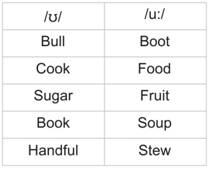
3 – (Whole class) – Play CD Listening 1 – Listen and check.
4 - Refer SS to the Phonetic symbols on page 14 – SS notice the usual spelling for the sounds /ʊ/ and /u:/.
Listening
1 – (Whole class) (Pre-listening) Talk to SS about the variety of cooking shows available on TV these days. Do accept comments from the open channel samples as well as the well known cable TV ones. Mention one or two examples to start them up if necessary.
a) Possible Answers: Their aims are to stimulate and influence people on doing their own cooking, eating more healthily and having fun at the same time, to help housewives with ideas, etc.
b) Free answer, but Jamie Oliver might come out as a favourite.
2 – (Whole class)(Listening for a gist) Make sure SS cover the song text for the listening.-
Play CD Listening 2.
a) Possible answer: The song is about food, drink and love – It gives directions on how to get fun with someone you like, involving cooking on the dating programme.
b) Answer: The male singer is celebrity chef Jamie Oliver. Ask SS to say whatever they know about him.
3 – (Individual) (Listening for details) Give SS some time to go through the song lyrics and ask them to try to guess the ingredients before filling in the gaps. Play CD listening 2. SS complete the text and then compare answers with their partners.
Answers: Oil – fish – wine – black pepper – salt – herbs – garlic - lemon
4 – (Whole class) Play CD Listening 2 once again and start singing along to encourage SS.
Menu Anterior